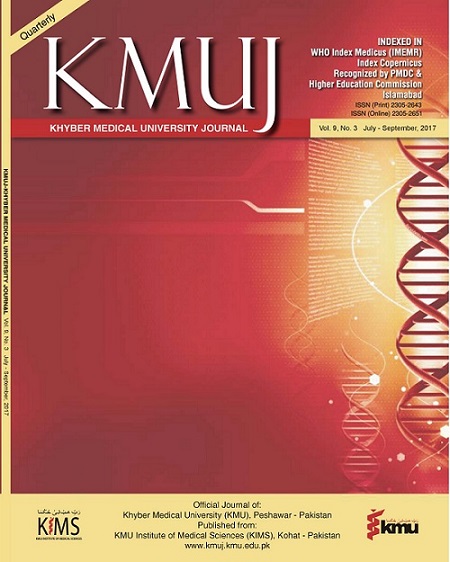FREQUENCY OF BETA THALASSEMIA TRAIT IN PREGNANT ANEMIC PATIENTS ATTENDING KHYBER TEACHING HOSPITAL, PESHAWAR-PAKISTAN
Main Article Content
Abstract
ABSTRACT
OBJECTIVE: To determine the frequency of beta thalassemia trait in pregnant anemic patients attending Khyber Teaching Hospital, Peshawar, Pakistan.
METHODS: This descriptive cross sectional study was conducted in Gynecology and Obstetrics Department of Khyber Teaching Hospital, Peshawar from 3rd November 2015 to 3rd May 2016. All pregnant women of any parity with hemoglobin value of <10.5g/dl presenting in first trimester and in age group of 15-45 years were included while pregnant anemic women who were already diagnosed cases of haemoglobinopathies were excluded.
RESULTS: Our study of 194 pregnant anemic patients showed that mean age was 27.74±5.16 years. The age distribution was 125 (64.43%) patients in 15-30 years age group and 69 (35.56%) patients in 31-45years age group. Mean hemoglobin level was recorded as 9.43±0.40 mg/dl and mean HbA2 was 4.26±0.52. Mean value for mean corpuscular volume was 60.23±1.57fl and for mean corpuscular hemoglobin was 21±0.42 g/dl. The results of our study for beta thalassemia trait in pregnant anemic patients were recorded as 110 (56.7%) were positive whereas 84(43.29%) had no beta thalassemia traits. Among 125 patients in 15-30 years’ age range, 65 (52%) were positive for beta thalassemia trait while out of the 69 pregnant anemic patients in age range of 31-45 years, 45 (65.2%) had beta thalassemia trait (p-value=0.113).
CONCLUSION: Beta thalassemia trait is very common and is found in more than half of pregnant anemic patients in our region.
KEY WORDS: Anemia (MeSH); Beta-Thalassemia (MeSH); Beta-Thalassemia Trait (Non-MeSH); Hemoglobins (MeSH); Antenatal Care (MeSH); Penatal Care (MeSH); Mortality (MeSH); Morbidity (MeSH).
Article Details
Work published in KMUJ is licensed under a
Creative Commons Attribution 4.0 License
Authors are permitted and encouraged to post their work online (e.g., in institutional repositories or on their website) prior to and during the submission process, as it can lead to productive exchanges, as well as earlier and greater citation of published work.
(e.g., in institutional repositories or on their website) prior to and during the submission process, as it can lead to productive exchanges, as well as earlier and greater citation of published work.
References
REFERENCES
Shawky RM, Kamal TM. Thalassemia intermedia: An overview. Egyptian J Med Hum Genet 2012; 13(3): 245-55. DOI: 10.1016/j.ejmhg.2012.03.006
Little MP, Brocard P, Elliott P, Steer PJ. Hemoglobin concentration in pregnancy and perinatal mortality: a London-based cohort study. Am J Obstet Gynecol 2005 Jul;193(1):220-6. DOI: 10.1016/j.ajog.2004.11.053
Usman M, Moinuddin M, Ghani R. Molecular genetics of beta-thalassaemia syndrome in Pakistan. East Mediterr Health J 2010 Sep; 16(9): 972-6.
Quek L, Thein SL. Molecular therapies in beta-thalassaemia. Br J Haemato 2007 Feb;136(3): 353-65. DOI: 10.1111/j.1365-2141.2006.06408.x
Stephanson O, Dickman PW, Johansson A, Cnattingius S. Maternal hemoglobin concentration during pregnancy and risk of stillbirth. J Am Med Assoc 2000 Nov; 284(20):2611-7.
Amanat S, Ikram N, Baqai HZ. Pattern of haemoglobin disorders. J Rawalpindi Med Coll 2012;16(1):15-8.
Khattak SA, Ahmad S, Anwar J, Ali N, Shaikh KH. Prevalence of various mutations in beta thalassaemia and its association with haematological parameters. J Pak Med Assoc 2012 Jan;62(1):40-3.
Hussain J, Arif S, Zamir S, Mahsud MAJ, Jahan S. Pattren of thalassemias and other haemoglobinopahties: a study in district Dera Ismail Khan, Pakistan. Gomal J Med Sci 2013;11(2):174-7.
Ansari SH, Shamsi TS, Ashraf M, Bohray M, Farzana T, Khan MT, et al. Molecular epidemiology of β-thalassemia in Pakistan: far reaching implications. Int J Mol Epidemiol Genet 2011;2(4):403-8.
Saleem M, Ahmad PA, Mubarik A, Ahmad SA. Distribution pattern of haemoglobinopathies in northern areas of Pakistan. J Pak Med Assoc 1985 Apr;35(4):106-9.
Yousafzai YM, Khan S, Raziq F. Beta-thalassaemia trait: haematological parameters. J Ayub Med Coll Abbotabad 2010 Oct-Dec;22(4):84-6.
Rouse DJ, MacPherson C, Landon M, Varner MW, Leveno KJ, Moawad AH, et al. Blood transfusion and cesarean delivery. Obstet Gynecol 2006 Oct;108(4):891-7. DOI: 10.1097/01.AOG.0000236547.35234.8c
Hafeez M, Aslam M, Ali A, Rashid Y, Jafri H. Regional and ethnic distribution of beta thalassemia mutations and effect of consanguinity in patients referred for prenatal diagnosis. J Coll Physicians Surg Pak 2007 Mar;17(3):144-7. DOI: 03.2007/JCPSP.144147.
Sinha M, Panigrahi I, Shukla J, Khanna A, Saxena A. Spectrum of anemia in pregnant Indian women and importance of antenatal screening. Indian J Pathol Microbiol 2006;49(3):373-5.
Mohanty D, Gorakshakar AC, Colah RB, Patel RZ, Master DC, Mahanta J et al. Interaction of iron deficiency anemia and hemoglobinopathies among college students and pregnant women: a multi center evaluation in India. Hemoglobin 2014;38(4):252-7. DOI: 10.3109/03630269.2014.913517.
Susanti AI, Sahiratmadja E, Winarno G, Sugianli AK, Susanto H, Panigoro R. Low hemoglobin among pregnant women in midwives practice of primary health care, Jatinangor, Indonesia: Iron deficiency anemia or β-thalassemia trait? Anemia 2017(2017) Article ID 6935648. DOI: 10.1155/2017/6935648.
Sarda H, Niveditha SR, Shivlingaiah N. Screening of β-thalassemia trait among pregnant women with NESTROFT. Thalassemia Reports 2015; 5(1). DOI: 10.4081/thal.2015.4430
